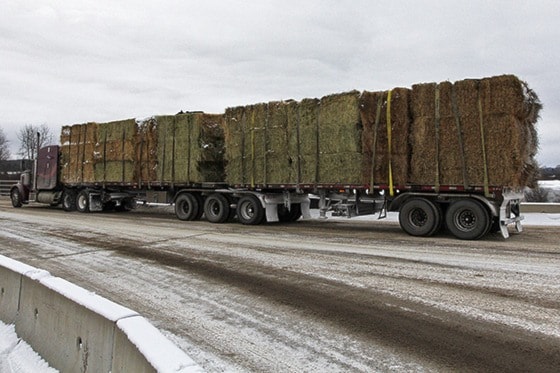Markets in Asia and the Far East are offering Nechako farmers high prices for hay.
The domestic price of hay, also known as alfalfa, has long been stagnant, largely due to oversupply. But in highly populated, resource-scarce nations abroad, like China, the United Arab Emirates and Vietnam, hay is up to five times more valuable, according to Mel Gulbranson, a local producer of hay with more than 35 years of farming experience in the central interior.
Hoping to capitalize on the global roundup of animal forage, Gulbranson is building a plant west of Vanderhoof that processes hay for export to countries in Asia and the Middle East.
Using a special baling machine, Gulbranson plans to compress hay into manageable sizes that can be loaded onto containers, transported to the port of Prince Rupert and shipped overseas.
"We've been looking into this for years," he said.
"We just needed to find a better market that would bring us farmers a decent return, and we finally found it. That was the hold up."
Almost 25 per cent of farm land in the Nechako region is used for cultivating hay and field crops to support livestock, according to the Ministry of Agriculture (MOA).
In 2011, area farmers produced a particularly large yield of mediocre quality hay that inundated the domestic market and dragged down prices.
A 45 per cent decline in the number of beef herds since 2006 has also led to an excess of hay in the Nechako numbering in the hundreds of thousands of tons, said Gulbranson.
Because of the surplus over the past two years, Gulbranson has managed to sell only a fraction of the several thousands of tons of hay he used to move annually.
"I know people who were selling hay for $20 per ton, and through our plant, it will be worth five times as much," he said.
When the plant starts producing, Gulbranson hopes to process the overabundance of hay in his fields and storage sheds for shipment to foreign markets.
"We will be purchasing some amount of hay off others, but most of it is going to come from our own farm," he said.
Sprawling with fertile agricultural land and less than nine hours away from the international shipping ports of Prince Rupert, the Nechako area is one of the most ideal logistical locations to build such a plant, as Robert Boelens, a provincial spokesman for the MOA, identified in an email.
"As Canada’s Pacific Gateway, B.C. is the closest connection Asian markets have to North America, and our ports deliver hundreds of millions of dollars worth of B.C. food products each year to customers in China and Japan," the MOA says.
"The opportunities for growth are huge."
Jud Wu, a businessman in the Nechako region, is also jumping on the forage bandwagon.
Using a compression machine and shipping containers, Wu is starting an operation east of Vanderhoof that processes only high-quality alfalfa for export to China.
“When I was in Vanderhoof a few weeks ago, I met Mr. Jud Wu and learned of the work being done to compress and export alfalfa,” said B.C. Agriculture Minister Norm Letnick.
“I am very optimistic that the combination of the high quality product and the proximity to the Chinese market will lead to success, and increased B.C. alfalfa exports to China.”
The high-quality alfalfa, which offers between 10 and 20 per cent more protein than regular hay, will be used as forage for some of China's 40 million dairy cows, a number that is increasing annually, said Wu.
"They can not make enough feed for their cows," he said.
With a population of more than 1.34 billion people, China, like many other densely-populated Asian nations, lacks the land and water needed to produce enough high-protein feed for its dairy cows.
"They need more from other parts of the world," he said.
"And we are the closest place to Asia that can grow good alfalfa."
Wu plans to send about 40,000 tons of alfalfa to Chinese ports annually, but it could take some time before Nechako farmers start producing the quantity and grade of hay that Wu desires.
Right now, there is a shortage of high-quality alfalfa in the area, said Richard Martens, a seasoned farmer who was born and raised in the region.
"The quality we have around here isn't dairy quality, so it's something we have to work towards producing," he said.
At a meeting with students from the University of Northern British Columbia on Oct. 26, Martens said the local production of hay could quadruple if markets continue to improve and farmers start utilizing their land to the fullest extent.
But there is still the issue of drying the crop for export, he added.
Depending on the weather and the level of moisture in the air, hay can take between three and seven days to dry when rolled into round bales, Martens explained.
"It's a very good crop in this area," said Martens, who produces about 4,500 tons of silage and hay each year on a dry matter basis.
"It's one of our better crops to grow and it grows very well here, it's just getting it dry - that's my biggest worry."
Boelens says the climate and soils in the Nechako are suited to producing high quality alfalfa, and that the region itself presents good growing opportunities for producers.
"The province supports these types of investments by building trade relationships with the Chinese government, investing in infrastructure such as the port in Prince Rupert, which is the closest port to Asia in North America, and creating a business environment that supports and rewards investment and innovation," the MOA says.
"The new factories reflect the private sector’s investment and belief their business model will work. China offers the potential of another large market for B.C. alfalfa producers."
